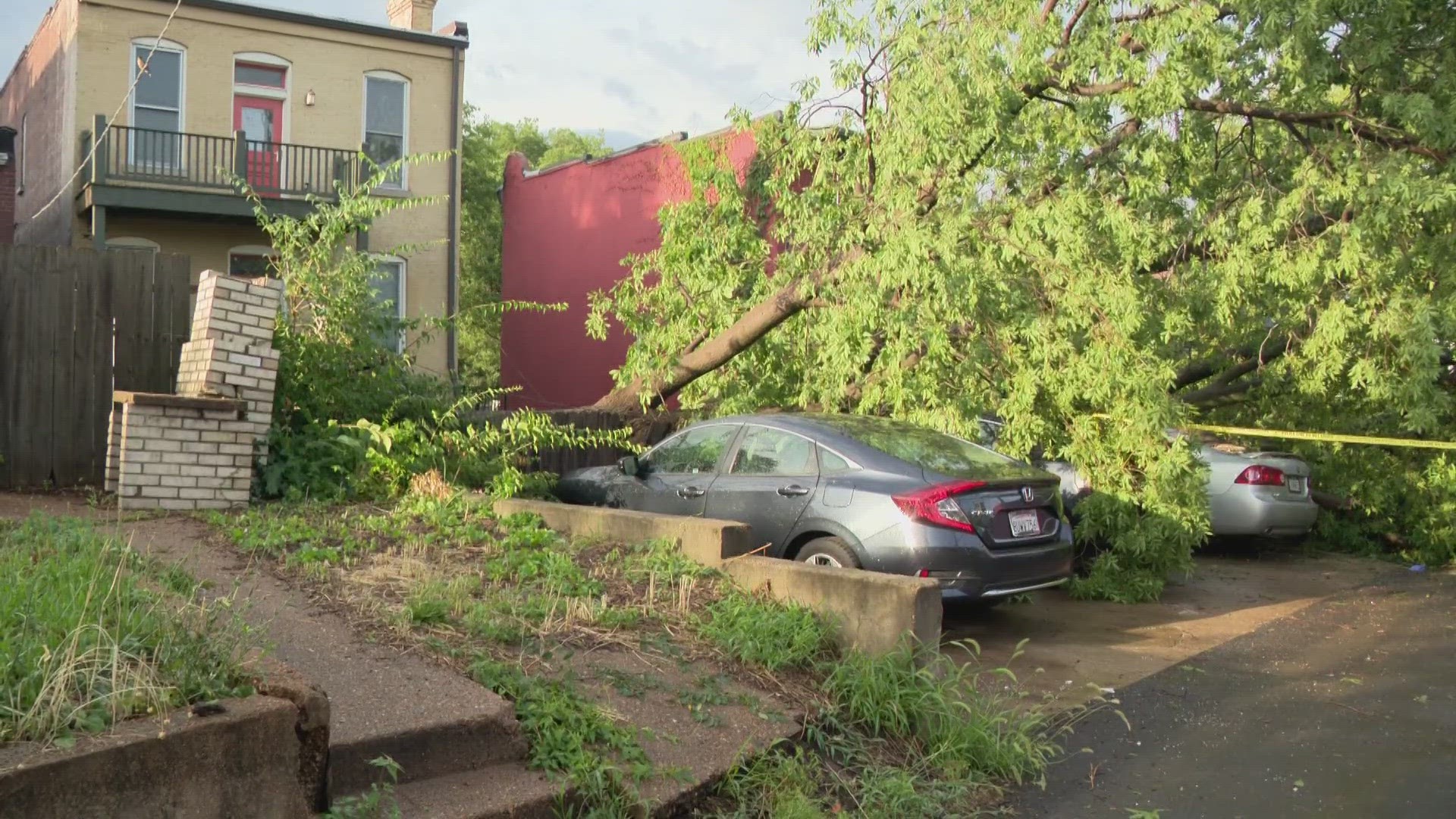ST. LOUIS — A severe thunderstorm impacted areas throughout the St. Louis region over the weekend, causing widespread power outages, storm damage and one reported death.
Note: The above video aired July 2, 2023.
Here are some tips and resources to help keep St. Louis area families safe under severe weather events throughout the remaining summer season.
The guidance provided below is from the 5 On Your Side Weather First Team, St. Louis National Weather Service, Ameren Missouri and Illinois, the U.S. Department of Health and Human Services and Hills Disaster Relief Network:
Be aware of severe weather conditions
According to the National Weather Service, severe thunderstorms can produce hail and wind gusts of more than 58 mph. Hail that is an inch or larger can damage home property and nearby vehicles. And wind can cause tree branches and limbs to break off and fall.
Thunderstorms can also produce tornadoes, flash flooding and lightning strikes in their path. Here's how to protect your family and home:
- Be aware of the difference between a Severe Thunderstorm Watch and a Severe Thunderstorm Warning. A watch is issued when outdoor conditions could produce a severe thunderstorm where a large population lives. Listen to NOAA weather radio and local weather news for real-time weather updates. The watch provides time for you and your family to prepare and get ready for a severe storm. A Severe Thunderstorm Warning is issued when a potentially dangerous storm has been identified by the NWS Doppler radar.
- Know the difference between a Storm Alert and Weather Alert. The Weather First Team will use Storm Alert to refer to life-threatening or major-impact weather conditions in our region. A Weather Alert refers to nuisance or disruptive weather and is indicated by orange icons and bars in our weather graphics on TV and online.
Safety tips during a severe weather threat
- Stay inside a sturdy building, hallway, stairwell, interior room or designated shelter to protect you from lightning, large hail, damaging winds and flooding rain.
- Stay away from windows, electrical tools and bodies of water.
- If you hear thunder, then you could be struck by lightning. Seek shelter from the thunder.
- Postpone outdoor activities until the storms have passed.
- If caught outside, take shelter in a sturdy enclosed building or hard-top vehicle.
- Find the nearest public space such as a gas station, store or restaurant to seek immediate shelter from the storm.
- Find a spot away from open spaces, single or metallic objects or high ground.
What to do with food during a power outage
According to FoodSafety.gov, a federal government website managed by the U.S. Department of Health & Human Services, here are some food safety tips during a power outage:
- Never taste suspicious food. Throw away any perishable food that has been above 40°F for more than two hours.
- Keep your refrigerator and freezer doors closed.
- Keep meat, seafood and dairy products cold.
- If it looks like the power outage will continue beyond a day, prepare a cooler with ice for your freezer items.
- Most other items such as jams and jellies, butter and margarine, ketchup, mustard, pickles, relish, and similar condiments, fresh uncut fruits and vegetables, can be kept on countertops until power is restored.
How to protect pets and other animals
- Microchip or collar ID your pet with the latest contact information.
- Install a pet rescue decal on your front door or window that first responders use to know a pet may be inside your home.
- Be aware of where your pet is at all times during the storm to prevent an evacuation mishap.
- Designate a pet-friendly place for your pet just in case you leave your home.
- Keep a photo of your pet just in case you are separated.
- Take your pet in a pet carrier or crate in the event you need to evacuate.
Resources for storm damage or power outage relief
- The American Red Cross can provide your family with emergency financial assistance after a storm has damaged your home.
- Find shelter with the Red Cross Shelter Locator which can help you find a nearby shelter during an emergency.
- Salvation Army offers disaster relief in the St. Louis region at a rapid rate. Find out what other service your area might be eligible for here.
- Call Ameren Illinois at 1-800-755-5000 immediately to report a downed line, natural gas odor or an outage.
- Stay away from downed power lines because these lines may still be energized.
- Stay away from brush, shrubs and fallen trees that may be hiding these lines.
The St. Louis County Office of Emergency Management has opened two shelters in response to the weekend's severe weather.
They are:
- North County Rec Plex, located at 2577 Redman Ave.
- Glasgow Elementary School, located at 10560 Renfrew Dr.
For guidance from the State Emergency Management Agency (SEMA) of Missouri and a reminder on how to prepare for unstable weather, click here.
You should treat a Severe Thunderstorm Warning the same as a tornado warning. To find out how to download mobile apps to receive text alerts and weather updates, click here.
Download the free 5 On Your Side app to get the latest watches and warnings and track conditions live with our interactive radar. Use the links below to download now.

